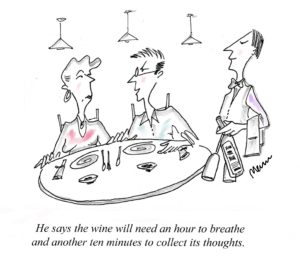
When is a wine ready to drink? It’s not so much a complicated or difficult question as it is a misunderstood one, we think. The great Orson Welles didn’t help matters when, in the 1970’s, he famously intoned in a series of TV commercials that Paul Masson (then, as today, a maker of cheap California jug wines) would “sell no wine before its time.”
In doing so, he reaffirmed the popular notion that time has important and generally beneficial effects on wine, and that maturation in a controlled environment does wine good. Well, yes. Sort of. But it isn’t time, per se, that is the agent of improvement in wine, so much as the chemical changes that occur when oxygen is introduced in minute but steady amounts over time.
Once, the only way to do this was by containment in clay amphorae (the ancient world’s choice) or the tightly-crafted wooden barrels which succeeded terra cotta as winemaking moved west and north in the first centuries of the common era. Handled this way, wine gradually became more composed, expressive and drinkable as O2 worked its magic. When the bottle and cork revolution came along, wine could be shipped sooner, making winemakers and brokers happy, secure in the knowledge that the job of finishing the wine (permeable cork standing in for wood or clay) could be left to the retailer or to the serious amateur in possession of a home cellar.
As often happens, a kind of feedback loop ensued. Increasingly, quality wine was built in such a way that it required long term aging. It’s from this era that the idea of ‘laying wine down’ dates. One cannot help surmising that a good deal of wine’s mystique is wrapped up in the conviction that one must patiently stand by as it takes its own sweet time to become table-ready.
Which only begs the question, since we can’t be sure what table-ready actually means. One can get the idea that the Victorian-era British liked their claret worn to the point of decrepitude. This aesthetic proved durable right into the mid-20th century when new varietally-labeled arrivals from Australia and South America successfully redirected the focus to fresher wine with vivid fruit flavors. It was one of many dramatic course-corrections that punctuate wine’s colorful historya and a gambit that paid off in the capture of heretofore untapped demographics.
Contemporary trends now seem poised for another shake-up, converging on a new consensus that the best wine is made when nothing is added and nothing taken away. But in the absence of or with very low additions of sulfur dioxide which otherwise would have the effect of maintaining a measured pace of maturation, such wines are in danger of taking up too much oxygen too quickly. To combat this tendency, winemakers must make every effort to stave off any contact with air during vinification. The result are wines that come from the bottle with an enormous capacity to absorb oxygen and that can be a little off kilter until they do. Often this just means patiently suspending judgment for a few minutes while the wine draws enough breath to right itself. The process may, however, continue for days, evolving to a peak of expressiveness before gradually declining.
Exactly how much time is required in any given case is highly variable and depends on whether one is aiming for simple drinkability or striving for the optimum experience the wine is capable of delivering.
Whether we cool our heels as wine matures in barrel or bottle, or twiddle our thumbs while we wait for our glass of natural wine to expand its lungs, there’s no escape from the waiting game wine seems pleased to play with us.